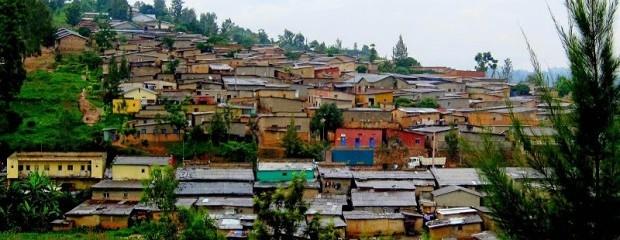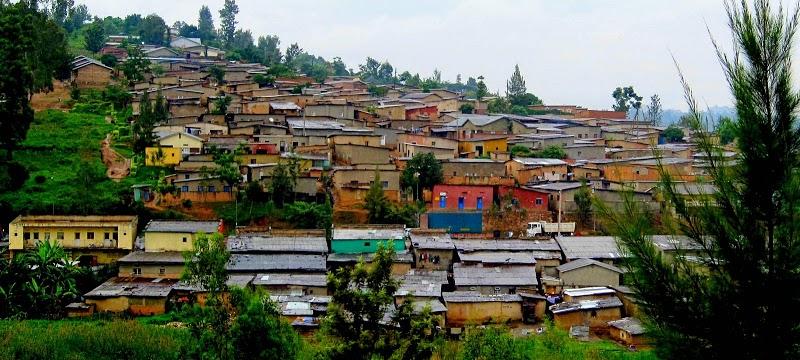Rwanda Twenty Years On: The Dangers of Demography – By Mark Weston

April 2014 marks the twentieth anniversary of the Rwandan genocide, three months of violence which saw the massacre of over 800,000 members of the Tutsi ethnic group at the hands of their Hutu compatriots. Thousands of Hutu moderates were also eliminated in a killing spree which left a third of the country’s population either dead or in refugee camps abroad. A survey conducted by UNICEF the year after the genocide found that 100% of surviving Rwandan children had witnessed violence, 88% had seen dead bodies or body parts, and 62% had been threatened with death. Nine in ten believed that they would die.
In December and January I spent a few weeks in Rwanda and neighbouring Burundi, another central African country which has been plagued by Hutu-Tutsi conflict and which, like Rwanda, experienced a debilitating civil war in the 1990s. Both countries are small, hilly and heavily cultivated. Both have young, predominantly rural populations who spend their days cultivating coffee, tea, bananas and subsistence crops on the steep, cloud-draped slopes. But there are growing differences between the two countries, and the paths they have taken since the early 1990s make it unusually easy on crossing the border to tell that you have entered a new nation.
Rwanda’s progress since the genocide has been remarkable. Most importantly, the country has remained stable. Hundreds of thousands of refugees have returned from the Congo, Burundi and Tanzania and been reintegrated into their communities. The justice system has convicted most of the worst genocidaires, while those who committed lesser crimes have paid their dues and returned to their villages. The threat from Hutu extremists who took refuge in neighbouring countries has been contained. A repeat of 1994’s horrific events has been avoided.
To cement the peace, Rwandan president Paul Kagame, who has led the country through most of the post-genocide period, has aped Turkey’s great nation-builder Ataturk in adopting a new flag, a new national anthem, and a new official language (in this case English). Provincial boundaries have been redrawn to erase the stains of tribal division. Umuganda days on the last Saturday of each month bring communities together to repair roads, build schools, plant trees and clean streets. And the country has begun to look outward, joining both the East African Community and the Commonwealth in 2009.
Perhaps more important to peaceful cohabitation is the removal of the causes for grievance that made the years leading up to the genocide so tense. The corruption that beset Juvenal Habyarimana’s presidency during the 1980s is a thing of the past: Rwanda is rated Africa’s least corrupt country by the watchdog Transparency International. Huge strides have been made in tackling the country’s historic underdevelopment – since 1990, when the civil war that preceded the genocide began, incomes have increased by nearly 60% (in Burundi they have declined over the same period); the gender gap has been closed, led from the top with women outnumbering men in parliament; infant mortality has more than halved, helping to push life expectancy up by twenty-three years (compared with an increase of just four years in Burundi); and infrastructure has been strengthened, with access to water, sanitation and paved roads greatly expanded. The visitor is immediately struck by how smart the country looks compared with its neighbours – its roads are in good shape, the streets are clean and by African standards quiet, the cities have parks with neatly mown grass, and sleek new skyscrapers are sprouting along the capital’s tree-lined avenues.
But what is equally obvious to the outsider is that Rwanda is full up, and that the risks posed by its demography threaten to undermine the progress made. In mainland Africa’s most densely populated country, there are people everywhere you look. Every slope, every hilltop is cultivated. With over 400 inhabitants per square kilometre, four in five of whom are engaged in agriculture, there is barely any spare land. Nor is there any sign of a letup. Fertility remains high, at almost five children per woman, and the population – and without a significant increase in out-migration its density – is projected by the United Nations to double by 2050. Already deforestation and over-intensive farming have led to soil erosion. Already the country has to import food. If climate change brings with it an increase in extreme weather events or unfavourable variations in rainfall, the fragile balance between population and land will tilt further in the wrong direction.
Population pressure has helped spark conflict in a number of African countries in recent years, with differences between ethnic groups, religions and regions brought into sharper relief as competition for scarce resources intensifies. Generational differences have also come to the fore, as young people realise that their elders have sequestered their nations’ treasures and positions of power. Rwanda’s demography is unlikely to shield it from this threat. Three in five are below the age of 25. The median age is nineteen years. With their dynamism and entrepreneurial spirit, young adults can help propel a country forward, but they can also be a source of unrest. Many conflicts in Africa – in Sierra Leone, Liberia, northern Nigeria, and in Rwanda and Burundi themselves – have been fuelled by young people’s resentment at the lack of opportunities as they reach adulthood.
Corruption and a growing gap between rich and poor have fanned the flames – Rwanda has addressed the first of these, but inequality is increasing and the failure to make a significant dent in the poverty rate (which fell from 67% to 62% between 1990 and 2011) suggests that the impressive growth in gross domestic product has benefited only a small urban elite.
In contexts where the size of the population outweighs the available jobs and resources, a large youth population can be a tinderbox. Denying young people an outlet for their frustrations exacerbates the risk of explosion. Paul Kagame has shepherded Rwanda through two peaceful and relatively prosperous decades and become a darling of donors in the process (foreign aid makes up two-fifths of his government’s annual budget), but his Western backers have largely turned a blind eye to the regime’s banning of political parties, jailing of rivals such as opposition leaders Victoire Ingabire and Bernard Ntaganda, and alleged extrajudicial murders of critics. Many people I spoke to during my stay in Rwanda were afraid to discuss politics at all; others warned me against asking questions.
A Belgian aid worker told of two European friends who had been deported in the last year, and claimed that the government has a sprawling network of informers, snapping up the brightest university students and paying them to dish the dirt. Armed soldiers and police lurk on every corner. Thousands of Hutus languish in exile in Congo or in overcrowded prisons. In its 2013 report, Amnesty International observed that there is ‘almost no space for critical journalism in Rwanda,’ and that the regime’s clampdown on private media outlets and its use of torture, illegal detentions and unfair trials to cow opponents has left ‘few independent voices in the country.’ In Reporters Without Borders’ 2014 World Press Freedom Index, Rwanda ranks 162nd of 180 countries.
For Kagame and his supporters, such steps are a necessary evil to prevent another genocide. As a young Tutsi man in a village in northern Rwanda told me in December, ‘It’s safe for us now. The government is ours. If a Hutu even says anything bad about Tutsis he can be reported to police.’ And herein lies Rwanda’s problem – during good times, people rub along well together and differences are pushed to the background. But as the population grows and the strain on land, food and jobs intensifies, Rwanda’s vulnerability to shocks – whether caused by climate change, conflict in a volatile neighbour, economic setbacks or a change of heart by key donors – will increase. If one of these or some other unforeseen shock occurs, the need for a scapegoat could resurface and the country’s buried demons re-emerge (the young northerner later told me that he and the few other Tutsis in his village never go into bars for fear that their drinks might be poisoned).
In the coming decades Rwanda’s people and its policy-makers will have diminishing room for manoeuvre – by stopping up outlets for free expression now and constricting that space further, Paul Kagame’s government risks raising the pressure to bursting point.
Mark Weston is the author of The Ringtone and the Drum: Travels in the World’s Poorest Countries. He lives in Tanzania.






The challenge with an article like this is that it is too subjective. I agree that demographics is a real and threatening challenge for Rwanda but it would have been useful to see what the government is doing and if it working. Second, would have been useful to interview people from all over Rwanda, heck even two per province, would given a more objective view. Also that stat on poverty levels doesn’t paint an accurate picture – would have been good to also mention the drastic drop in extreme poverty and why.
Demography and the explosion in the African population coupled with extreme unemployment and youth in age is a social political governance ‘time bomb’. Unless prescriptive reasoned transformative leadership is prepared to exercise difficult choices when considering options—the future outcome for sub-saharan africa is grim, dire and will be robust with unfettered violence. The Leadership Class in sub-saharan Africa must realize that the old way of governance is over—-finished. Unless immediate positive accountable prescriptive change in governance process and procedure is implemented now—watch and witness sub-saharan Africa ignite in a ‘brule’ which will set this most excellent region of the world back into a region of classic Hobbes where life will be both “brutish violent and short”.
Monte McMurchy
Kinshasa
DRC
Mark,
There are many things regarding Rwanda about which one has to agree to disagree. But standard, internationally validated statistics should not be one of them. I invite you to correct your paragraph 8, after consulting The Evolution of Poverty in Rwanda from 2000 to 2011 (NISR 2012, on the web). Inequality is NOT increasing now (in contrast with 2000-2005), and it makes no sense to assess the poverty impact of recent growth by comparing poverty rates for 1990 and 2011! These mistakes detract from the good points you make. They are also harmful, because, having been published in a prominent blog, they will now be repeated by all and sundry writing about Rwanda.
David, the poverty data are World Bank $1.25/day poverty data. I took 1990 as the starting point because that was pre-genocide and before the rise of the current government. 1994 would have been another possible starting point, but any year after that would have been random. If you can point me to some inequality data showing declines or stagnation over the past two decades, I would be happy to correct the article.